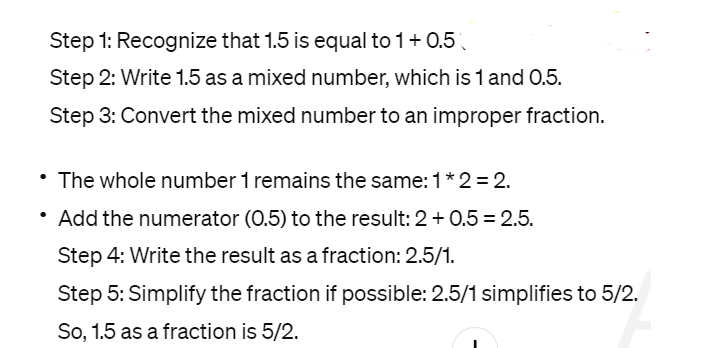1.5 as a Fraction & More : Quiz on Fractions
Understanding fractions is fundamental in mathematics. They represent a part of a whole and are used extensively in various mathematical operations. In this article, we will delve into the concept of fractions, specifically focusing on converting 1.5 into a fraction.
Understanding Fractions
Understanding fractions involves grasping the concept of parts of a whole or parts of a set. In a fraction, the top number (numerator) represents the number of parts we have, while the bottom number (denominator) represents the total number of equal parts that make up a whole.
For example, in the fraction 3/4:
- The numerator (3) indicates that we have 3 parts out of the whole.
- The denominator (4) tells us that the whole is divided into 4 equal parts.
So, 3/4 means we have three out of four equal parts of something.
Fractions can also represent values between whole numbers. For instance, 1/2 represents half, 1/4 represents one-fourth, and so on.
Understanding fractions involves knowing how to add, subtract, multiply, and divide them, as well as converting between fractions, decimals, and percentages. Fractions are fundamental in various mathematical operations and real-life situations, such as cooking, measurements, and financial calculations.
Steps Involved in finding 1.5 as a Fraction

Converting Decimals to Fractions
Converting decimals to fractions is a common mathematical operation. To convert a decimal to a fraction, we utilize the place value system. In the case of 1.5, we can convert it to a fraction by expressing it as 15/10.
Simplifying Fractions
Once we have expressed a decimal as a fraction, it's often necessary to simplify it to its simplest form. Simplifying a fraction involves dividing both the numerator and denominator by their greatest common divisor. For 15/10, the simplified form would be 3/2.
Common Questions and Misconceptions
Many individuals often have questions and misconceptions regarding fractions, including the concept of converting decimals to fractions. Some common queries include whether fractions can represent non-integer values and how to simplify fractions effectively.
Real-life Applications
Understanding fractions, including the conversion of decimals to fractions, has numerous real-life applications. From cooking recipes to engineering calculations, fractions play a crucial role in various fields. For instance, in cooking, recipes often require measurements such as 1.5 cups of flour, which can be expressed as 3/2 cups.
Conclusion
In conclusion, fractions are essential in mathematics and everyday life. Converting decimals to fractions, such as 1.5, allows us to express non-integer values in a more versatile form. By understanding the fundamentals of fractions and their applications, we can enhance our problem-solving skills and mathematical proficiency.
FAQs
-
Can fractions represent non-integer values?
- Yes, fractions can represent both integer and non-integer values. They are versatile mathematical tools used to express parts of a whole.
-
How do you simplify fractions?
- To simplify fractions, divide both the numerator and denominator by their greatest common divisor until they cannot be divided further.
-
What is the difference between proper and improper fractions?
- Proper fractions have a numerator smaller than the denominator, while improper fractions have a numerator equal to or greater than the denominator.
-
Are mixed numbers considered fractions?
- Yes, mixed numbers consist of a whole number and a fraction and are considered a type of fraction.
-
In what scenarios are fractions commonly used?
- Fractions are used in various scenarios, including cooking measurements, construction, engineering calculations, and financial calculations
Why not try out games to see how it changes the dynamics.
Go to pageInteractive games can help in school.
Go to pageTry out the 5th grade math collection.
Go to pageOnline math tests make a difference.
Go to pagePlay games and learn at the same time.
Go to page










